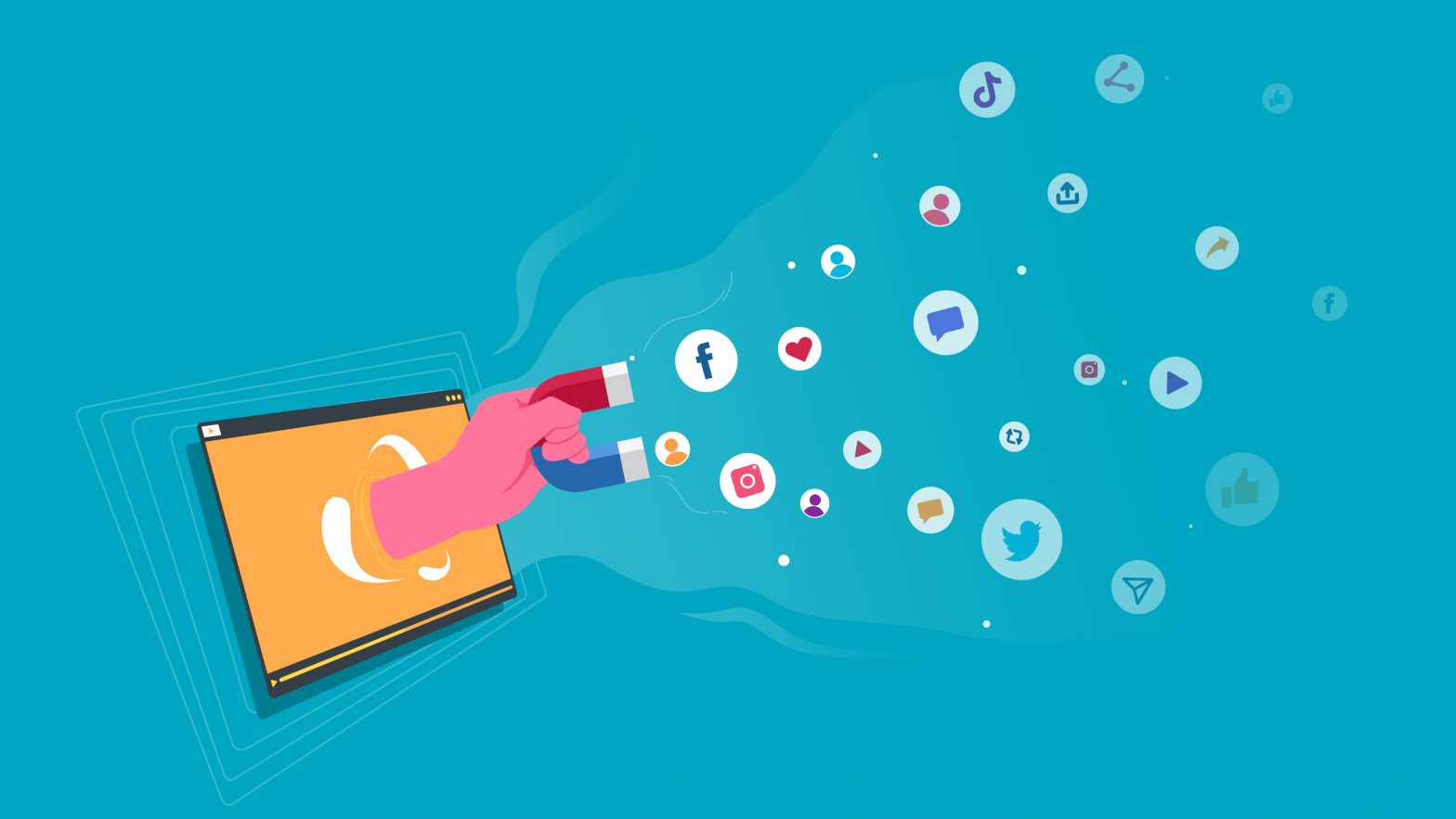More marketers and brands now use motion graphics on their social media pages instead of static texts and images or long-form video content.
While videos do well to relay detailed information, motion graphics grab attention instantly. There is no need for video thumbnails to attract viewers. Social media motion graphics splash right away on their screens.
According to Twitter, Tweets with a GIF have 55% more engagement than not having them. Motion graphics spur the interest of social media netizens to interact with your posting.
Moreover, 80% of all Internet traffic in 2021 will be video traffic in a forecast by Cisco. Online users also prefer shorter videos nowadays. In a 2018 study, videos less than 60 seconds had a 68% completion rate. On the other hand, longer videos have a 25% completion rate, which means that people prefer to watch shorter content.
And what could be shorter than social media motion graphics that do not need to test the patience, Internet speed, or attention span of users?
What Are Motion Graphics?
This type of media is different from a video. Motion graphics can have certain parts or elements that move. These can be a text marquee, logos and icons with accompanying animations, and images that contain movement.
The resulting output of motion graphics is a digital illusion that it is moving or rotating. It can be an incredible addition to an otherwise bland social media post that lacks engagement.
What Are the Types of Motion Graphics?
With several formats to choose from, you can use motion graphics on social media for various purposes. Learn to know which one to use, depending on the intent of your posting.
- GIFs
The abbreviation means Graphics Interchange Format, a lossless bitmap image. It contains a series of images or frames that you can animate. This one is the most common type of motion graphics that you can see almost everywhere online.
Depending on the user’s Internet settings, GIFs can play automatically, or they would need to press play first. GIFs have widespread use on Twitter as well as on Facebook.
Best to use for: Moving texts, icons, and repetitive actions.
- Cinemagraphs
This format looks like a static image on the first look. However, when you look closely, cinemagraphs have certain parts or elements that move. It has a subtle movement emphasizing minimal actions.
Cinemagraphs have this aesthetic and cinematic appeal, which works well with clothing, food, or other product images that need a dramatic visual impact. They are versatile, and you can use them on Facebook, Pinterest, or Instagram.
Best to use for: Accentuate a part of the graphics, such as wind blowing, smoke movement, water splash, or animated background.
- Explainer videos
When you need to explain ideas or provide instructions more clearly, explainer videos can help illustrate them. What you are doing here is transforming human elements and products into a moving animated format.
You can have explainer videos that are less than a minute or make a longer one, depending on the product or information you are trying to convey. This format works well across various social media platforms, including Facebook, YouTube, or IGTV.
Best to use for: When you need to explain products and information in a fun, interactive manner.
- Animated infographics
Typically, infographics only contain a collection of charts and graphs that translate numbers. You can take it up a notch by adding animations to certain parts of the graphs. For instance, you can use an animated arrow that goes upwards to indicate a rising trend.
While a long-form type of content, you can also craft animated infographics in a shorter version and take advantage of the animations to display data. You can post them more appropriately on Facebook, where users prefer to view or consume content packed with information.
Best to use for: Bringing static charts, graphs, and reports to a more engaging presentation.
Why Use Motion Graphics for Social Media?
Incorporating motion graphics helps to visualize social media posts more effectively. The following reasons are among how your social marketing campaigns can benefit from using social media motion graphics.
- Catch Attention Instantly
Motion graphics make social media users notice the content right away instead of scrolling past them. With an eye-catching design that pops out of their screens, you can direct their attention to your post. Even better, they may even go to your page or profile when they are genuinely interested in the content you put up.
- Explain Ideas Easily
You can quickly convey information with motion graphics through the effective use of moving elements and texts. Simple images are static, providing a limited experience to the user. Motion graphics, on the other hand, can condense hard-to-understand data through the use of movements. It keeps the user engaged as well. You can provide instructions or highlight a moving piece of the image.
- For Brand Awareness
Another key benefit of motion graphics is the ability to make people aware of your brand. Especially for people who may not know your business yet, motion graphics are useful for brand exposure. Posting them on social media makes people curious about your brand. With motion graphics as the lead magnet, you can hook them up to be interested in what you can offer them.
- Interesting and Memorable Content
With so much content on someone’s social media feed, it can be tricky to post one that people will remember. Enter motion graphics with its tendency to wow your audience.
People are more likely to be interested in a social media post that stands out. Consider using a social media post generator to create captivating posts seamlessly using AI in just minutes. Whether it is a promo banner, header, or logo, motion graphics carves a memory for the user who saw your page or content.
- Get More People To Engage and Share
Social media marketing relies heavily on engagements and shares to spread the word about a brand. When you use motion graphics, you captivate the users, leading them to react and share the content with their friends.
Other formats, such as images or longer videos, can do this as well. However, motion graphics are the quickest way to go viral. Think about GIF memes which a lot of netizens use to express their reactions. The same level of engagement could happen to your social media content with motion graphics.
- It Is Cost-Effective
Having moving graphics is not expensive as you can even do it yourself through various software for simple animations. If you need to have it professionally done, you can tap skilled designers to craft motion graphics that will best represent your brand on social media. They are less costly than full-blown video production and editing.
How Do You Make Motion Graphics for Social Media?
Crafting motion graphics is simpler nowadays, with several choices available. Whether you decide to do it yourself with software or have someone else do it for you, here are some options to get you started with motion graphics:
- Online tools
Tools such as Canva or Filmora are great for simple motion graphics. Be creative and combine the various features and capabilities of these platforms. The simple animations and editing tools available allow you to suit the movement you want to accomplish.
- Marketing agencies
If you want to invest in proper motion graphics, marketing agencies can provide you with full-service coverage. Their service can include the initial creative brief consultation to even the production shoots you require to produce the animated material.
- Design services
Alternatively, subscribing to unlimited graphic design services is also one way to have motion graphics for your social media content. These cloud-based graphic services have skilled designers who can create either image, video, or both. Thus, taking away the problem when you need motion graphics on demand.
Effective Use of Motion Graphics for Social Media Content
Create motion graphics that are interactive and responsive enough on smaller screens. This is because, most of the time, people access social media on their mobile devices with smaller screen sizes. In the United States, about 97.2% of active users use mobile devices to access social media.
Get more people to notice your motion graphics by focusing less on distracting and subtle movements. As much as you want to impress social media users with all the flashy elements, it is best to stick with simple motions that do not overwhelm them.
Author: Raffy Montehermoso is a content writer for the graphic design service, Delesign.








